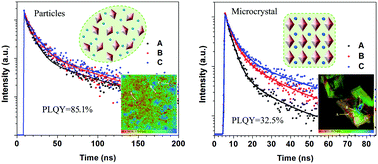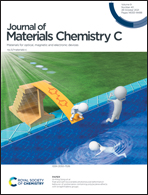High fluorescence efficiency of intrinsic ligand-free zero-dimensional Cs4PbBr6 particles and microcrystals†
Abstract
Ligand-free Cs4PbBr6 particles of sub-micron dimensions were fabricated by a simple tip-sonication method showing 85.1% photoluminescence quantum yield (PLQY). Cs4PbBr6 microcrystals can be grown under saturated vapor pressure with the particles as nucleation units. Surface traps are the main defects in the Cs4PbBr6 particles with smaller size, whereas bulk defects dominate in the larger microcrystals. The intensity of the low energy PL peak increases with excitation intensity at low temperature, which can be assigned to band filling and charge transfer effects. The exciton binding energy of Cs4PbBr6 particles is 180 meV which is almost twice that of the Cs4PbBr6 microcrystals. Such tight binding of the excitons facilitates exciton radiative recombination. In addition, the long excited-state lifetime of the Cs4PbBr6 particles contributes to the higher PLQY compared to that of comparable microcrystals. Time-resolved emission microscopy images clearly indicate different recombination kinetics in the ordered and defect regions, which is hidden in ensemble measurements. This strongly suggests that surface trap states are the main reason for the high-efficiency photoluminescence of the intrinsic Cs4PbBr6 particles investigated here, although both surface and bulk traps can emit light.



 Please wait while we load your content...
Please wait while we load your content...